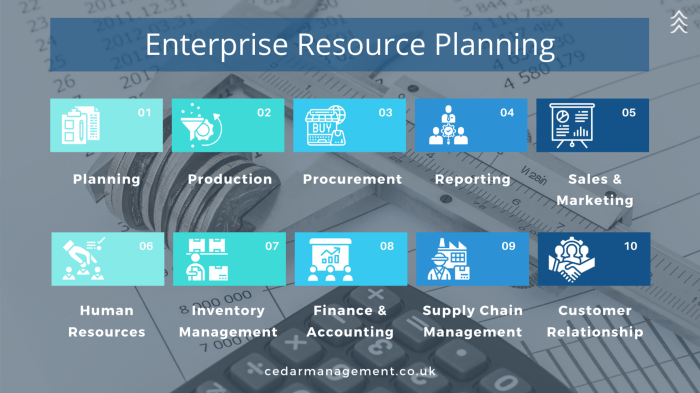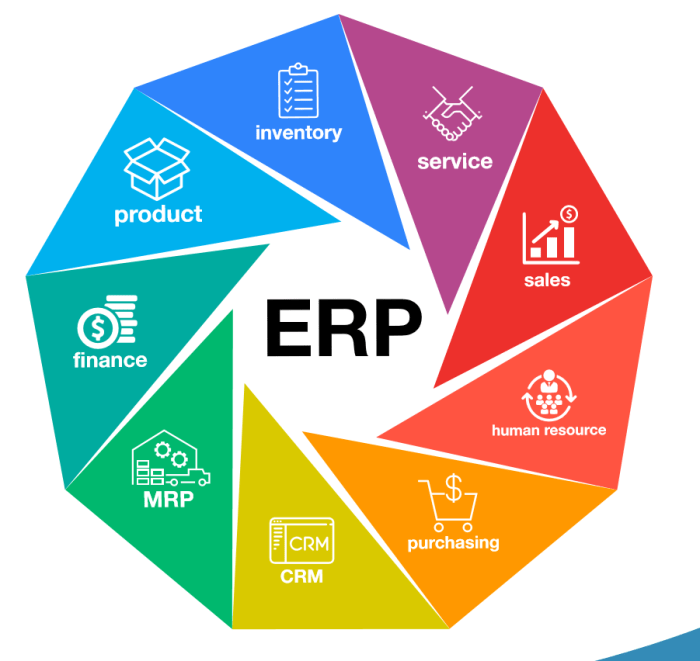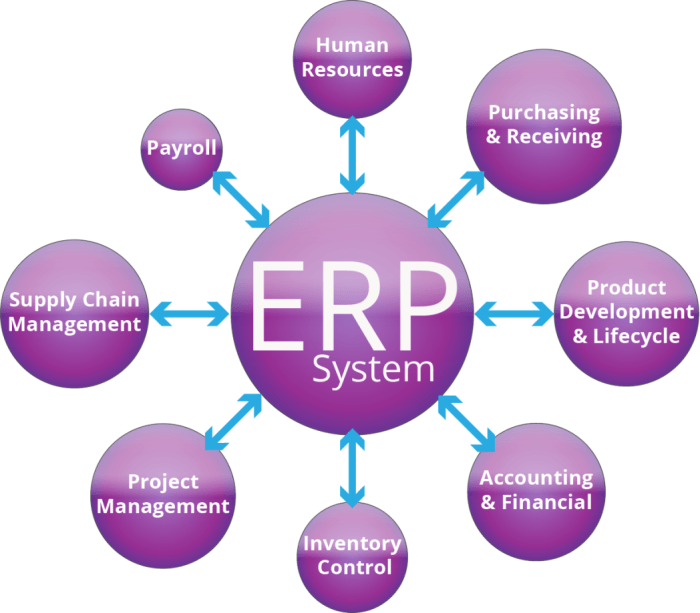ERP Inventory: Streamlining Your Supply Chain
Originally posted 2024-09-09 19:38:00.
ERP Inventory, a powerful tool for businesses, revolutionizes supply chain management by offering real-time visibility, automation, and data-driven insights. This comprehensive system integrates all aspects of inventory control, from procurement and warehousing to shipping and demand forecasting, creating a streamlined and efficient process.
Imagine a world where you always have the right products in stock, meeting customer demand without excessive inventory holding costs. This is the promise of ERP inventory management. By automating tasks, optimizing inventory levels, and providing accurate forecasting, ERP systems empower businesses to make informed decisions and maximize their profitability.
Introduction to ERP Inventory Management
ERP inventory management is a crucial aspect of any business that relies on physical products. It involves the use of an Enterprise Resource Planning (ERP) system to manage all aspects of the inventory lifecycle, from procurement and storage to sales and distribution.
ERP systems provide a centralized platform for tracking inventory levels, managing orders, and controlling costs. By integrating inventory data with other business processes, ERP systems enable companies to gain a comprehensive view of their inventory operations and make more informed decisions.
Benefits of Implementing an ERP System for Inventory Control
Implementing an ERP system for inventory control offers numerous benefits, including:
- Improved Inventory Accuracy:ERP systems provide real-time visibility into inventory levels, reducing the risk of stockouts or overstocking.
- Reduced Inventory Costs:By optimizing inventory levels and minimizing waste, ERP systems can significantly reduce inventory holding costs.
- Enhanced Supply Chain Visibility:ERP systems enable companies to track the movement of inventory throughout the supply chain, improving efficiency and responsiveness.
- Better Customer Service:With accurate inventory data, companies can fulfill orders promptly and meet customer expectations.
- Streamlined Operations:ERP systems automate many inventory management tasks, freeing up employees to focus on more strategic activities.
Common ERP Inventory Modules and Their Functionalities
Most ERP systems include a variety of inventory management modules, each designed to address specific aspects of inventory control. Some common modules include:
- Purchase Order Management:This module helps companies manage the procurement process, from creating purchase orders to tracking vendor performance.
- Inventory Receiving:This module facilitates the receipt of goods into the warehouse, including verifying quantities and inspecting quality.
- Warehouse Management:This module manages the storage and movement of inventory within the warehouse, including bin location assignments and picking and packing processes.
- Inventory Control:This module tracks inventory levels, monitors stock movements, and generates reports on inventory performance.
- Sales Order Management:This module manages customer orders, including order fulfillment and shipment tracking.
Core Functions of ERP Inventory Management
An ERP inventory management system serves as the backbone of a company’s supply chain, facilitating seamless inventory control, efficient warehouse operations, and accurate demand forecasting. It streamlines processes, reduces costs, and improves overall supply chain visibility.
Purchase Order Management
Purchase order management within an ERP system automates the process of ordering goods from suppliers. It ensures timely procurement of necessary materials and components, minimizing stockouts and production delays. The system facilitates the creation, approval, and tracking of purchase orders, ensuring accurate communication with suppliers and maintaining a record of all transactions.
- Automated Purchase Order Generation:The system can automatically generate purchase orders based on predefined criteria, such as reorder points or demand forecasts. This streamlines the ordering process and reduces manual errors.
- Supplier Management:ERP systems allow for comprehensive supplier management, including vendor onboarding, performance tracking, and contract negotiation. This ensures that businesses work with reliable suppliers and negotiate favorable terms.
- Purchase Order Tracking:The system provides real-time visibility into the status of purchase orders, allowing businesses to track orders from placement to delivery. This helps in managing delivery timelines and avoiding delays.
Inventory Tracking and Forecasting
Accurate inventory tracking and forecasting are crucial for maintaining optimal inventory levels, minimizing waste, and avoiding stockouts. ERP inventory management systems provide comprehensive tools for real-time inventory tracking, demand forecasting, and inventory optimization.
- Real-time Inventory Visibility:ERP systems provide a centralized platform for tracking inventory levels across all locations and warehouses. This enables businesses to get a real-time view of their inventory, ensuring accurate stock availability information.
- Demand Forecasting:ERP systems use historical data and statistical models to predict future demand for products. This helps businesses plan production and procurement activities effectively, minimizing stockouts and overstocking.
- Inventory Optimization:By analyzing inventory data, ERP systems can identify areas for optimization, such as reducing lead times, minimizing storage costs, and improving inventory turnover rates.
Warehouse Management
Warehouse management is a critical aspect of inventory management, involving tasks such as receiving, storing, and picking goods. ERP systems provide comprehensive tools for warehouse management, enabling businesses to optimize warehouse operations, minimize errors, and improve efficiency.
- Warehouse Layout and Space Optimization:ERP systems allow for the mapping of warehouse layouts and the optimization of storage space allocation. This helps businesses maximize storage capacity and minimize the risk of bottlenecks.
- Inventory Receiving and Put-Away:ERP systems automate the process of receiving goods, verifying quantities, and assigning them to specific storage locations. This ensures accurate inventory tracking and reduces the risk of errors.
- Order Picking and Shipping:ERP systems provide tools for efficient order picking, packing, and shipping. This helps businesses streamline order fulfillment processes and improve customer satisfaction.
Shipping and Receiving
Efficient shipping and receiving processes are essential for ensuring timely delivery of goods and minimizing transportation costs. ERP systems streamline these processes by providing tools for tracking shipments, managing carrier relationships, and generating shipping documents.
- Shipment Tracking:ERP systems provide real-time tracking of shipments, allowing businesses to monitor the progress of deliveries and ensure timely arrival of goods. This helps in managing customer expectations and avoiding delays.
- Carrier Management:ERP systems enable businesses to manage carrier relationships, negotiate rates, and track carrier performance. This helps in optimizing shipping costs and ensuring reliable delivery services.
- Shipping Document Generation:ERP systems automate the generation of shipping documents, such as invoices, packing slips, and bills of lading. This reduces manual effort and ensures accuracy in documentation.
Demand Planning
Demand planning is the process of forecasting future demand for products and services. ERP systems provide tools for demand planning, enabling businesses to accurately predict future demand, optimize production and procurement activities, and minimize stockouts.
- Demand Forecasting:ERP systems use historical data and statistical models to predict future demand for products. This helps businesses plan production and procurement activities effectively, minimizing stockouts and overstocking.
- Sales and Marketing Integration:ERP systems can integrate with sales and marketing data to provide a more accurate view of customer demand. This helps in aligning production and procurement with actual market demand.
- Demand Planning Scenarios:ERP systems allow businesses to create and analyze different demand planning scenarios, such as seasonal variations, economic fluctuations, and new product launches. This helps in making informed decisions and adapting to changing market conditions.
Best Practices for Effective ERP Inventory Management
Optimizing inventory levels is crucial for any business, and effective ERP inventory management plays a pivotal role in achieving this goal. By leveraging the capabilities of an ERP system, organizations can streamline their inventory processes, reduce costs, and improve customer satisfaction.
ERP inventory management is a critical component of any successful business, ensuring accurate tracking of stock levels, streamlining procurement processes, and optimizing supply chain operations. For businesses seeking a robust and reliable ERP solution, the NAVISION ERP SYSTEM offers comprehensive inventory management capabilities, including real-time stock visibility, automated purchase orders, and advanced reporting tools, ultimately empowering businesses to achieve greater efficiency and profitability in their inventory operations.
Optimizing Inventory Levels
Optimizing inventory levels is essential for ensuring that businesses have enough stock to meet demand without incurring excessive holding costs. Here are some best practices for achieving optimal inventory levels:
- Implement ABC Inventory Analysis:This method categorizes inventory items based on their value and usage. A-items, the most valuable and frequently used items, require more attention and tighter control. B-items, with moderate value and usage, require a balance between control and cost. C-items, the least valuable and infrequently used items, can be managed with simpler methods.
By focusing on the most critical items, businesses can allocate resources effectively.
- Utilize Safety Stock Calculations:Safety stock acts as a buffer to mitigate potential stockouts due to unexpected demand surges or supply chain disruptions. Implementing robust safety stock calculations, considering factors like lead time, demand variability, and service level targets, helps ensure that businesses can meet customer needs even in unpredictable situations.
- Employ Forecasting Techniques:Accurate demand forecasting is crucial for determining optimal inventory levels. By utilizing statistical forecasting models, historical data analysis, and market trend insights, businesses can anticipate future demand patterns and adjust inventory levels accordingly.
- Implement Reorder Point Systems:Reorder points define the trigger level for placing new orders. Establishing clear reorder points based on lead times, demand rates, and safety stock levels helps prevent stockouts and ensures timely replenishment.
Data Accuracy and Real-Time Visibility
Accurate data and real-time visibility are critical for effective ERP inventory management.
- Ensure Data Integrity:Maintaining accurate inventory data is essential for making informed decisions. This involves implementing data validation rules, regular data audits, and automated data reconciliation processes to minimize errors and ensure data reliability.
- Real-Time Inventory Tracking:Real-time visibility into inventory levels allows businesses to monitor stock fluctuations, identify potential shortages, and proactively adjust replenishment strategies. This can be achieved through barcode scanning, RFID technology, and automated inventory tracking systems integrated with the ERP.
Implementing Inventory Control Measures
Implementing robust inventory control measures within an ERP framework is crucial for maintaining optimal inventory levels and minimizing losses.
- Establish Clear Inventory Policies:Defining clear inventory policies, such as stock rotation procedures, minimum and maximum stock levels, and inventory valuation methods, provides a framework for consistent inventory management practices.
- Implement Cycle Counting:Regular cycle counting involves physically verifying inventory levels against system records. This helps identify discrepancies, improve data accuracy, and prevent stockouts or overstocking.
- Utilize Inventory Management Tools:ERP systems offer various inventory management tools, such as lot tracking, serial number management, and warehouse optimization tools, to enhance inventory control and efficiency.
Challenges and Considerations in ERP Inventory Implementation

Implementing an ERP inventory system, while promising numerous benefits, presents several challenges that organizations must address to ensure a successful and impactful rollout.
ERP inventory management is crucial for businesses of all sizes, ensuring accurate stock tracking and seamless order fulfillment. For Shopify merchants, integrating an SHOPIFY ERP solution can streamline operations, automating processes and providing real-time visibility into inventory levels across all sales channels.
This integration can enhance overall efficiency, leading to better inventory control and a smoother customer experience.
User Training and System Integration
Effective user training is crucial for successful ERP inventory implementation. Users need to understand the system’s functionalities, data input requirements, and reporting capabilities to maximize its potential. Insufficient training can lead to errors, data inconsistencies, and low user adoption.
Effective ERP inventory management hinges on real-time data accuracy, which can be challenging when dealing with dispersed devices. To ensure your IT infrastructure is properly monitored and maintained, consider utilizing a remote monitoring and management (RMM) solution like SYNCRO RMM PRICING.
This can help you proactively identify and address potential issues before they impact your inventory management processes, leading to improved efficiency and reduced downtime.
- Comprehensive Training Programs:Organizations should invest in comprehensive training programs that cover all aspects of the ERP inventory system, including data entry, inventory management, reporting, and troubleshooting.
- Hands-On Training:Hands-on training sessions with real-world scenarios and practical exercises allow users to gain practical experience and build confidence in using the system.
- Ongoing Support:Continuous support through user manuals, FAQs, and dedicated help desks is essential to address user queries and provide ongoing assistance.
System integration is another critical aspect of ERP inventory implementation. Integrating the ERP system with existing systems, such as accounting software, warehouse management systems (WMS), and customer relationship management (CRM) systems, ensures data consistency and smooth workflow.
- Data Synchronization:Integration ensures data synchronization between different systems, preventing data duplication and discrepancies.
- Automated Processes:Integrating systems can automate processes, reducing manual effort and errors, and improving efficiency.
- Real-Time Visibility:Integrated systems provide real-time visibility across different departments, enhancing decision-making and improving supply chain management.
Choosing the Right ERP System
Selecting the right ERP system is crucial for achieving desired outcomes. Organizations should consider factors such as their specific business needs, industry, size, and budget.
- Industry-Specific Features:ERP systems tailored to specific industries, such as manufacturing, retail, or healthcare, offer features and functionalities relevant to their unique requirements.
- Scalability and Flexibility:The ERP system should be scalable to accommodate future growth and flexible enough to adapt to changing business needs.
- Cost and Return on Investment (ROI):Organizations need to carefully evaluate the cost of implementation, ongoing maintenance, and the potential ROI.
Other Challenges, ERP INVENTORY
- Data Migration:Migrating data from existing systems to the new ERP system can be complex and time-consuming, requiring careful planning and execution.
- Change Management:Implementing an ERP inventory system requires significant changes in business processes and workflows, which can be met with resistance from employees. Effective change management strategies are crucial for minimizing disruptions and fostering user acceptance.
- Security and Compliance:Organizations must ensure that the ERP system complies with relevant industry regulations and security standards to protect sensitive data.
Future Trends in ERP Inventory Management

The world of inventory management is constantly evolving, driven by technological advancements and changing business needs. Emerging technologies like Artificial Intelligence (AI), the Internet of Things (IoT), and cloud-based solutions are transforming how businesses manage their inventory, paving the way for greater efficiency, accuracy, and responsiveness.
Artificial Intelligence (AI) and Machine Learning
AI and machine learning are revolutionizing inventory management by enabling smarter and more data-driven decision-making.
- Demand Forecasting:AI algorithms can analyze historical sales data, market trends, and external factors to generate more accurate demand forecasts, reducing stockouts and overstocking.
- Inventory Optimization:AI-powered systems can optimize inventory levels by considering factors like lead times, demand variability, and storage costs, leading to reduced holding costs and improved inventory turnover.
- Automated Ordering:AI can automate the ordering process by identifying optimal reorder points and quantities, freeing up human resources for more strategic tasks.
For example, Amazon utilizes AI-powered algorithms to predict customer demand and optimize inventory levels across its vast network of warehouses. This enables Amazon to keep products in stock and fulfill orders quickly, while minimizing storage costs.
Efficient ERP inventory management is crucial for businesses to optimize their supply chain and ensure timely delivery of products. Choosing the right ERP system is essential for streamlining these processes, and TOP ERP SYSTEMS can help you find the ideal solution.
By evaluating your specific needs and exploring different options, you can select an ERP system that effectively manages your inventory, improves operational efficiency, and enhances overall business performance.
Internet of Things (IoT)
The IoT is connecting physical assets to the internet, enabling real-time data collection and analysis for improved inventory visibility and control.
- Real-Time Inventory Tracking:IoT sensors can track inventory movement and location in real time, providing accurate and up-to-date inventory information. This eliminates manual counting and reduces discrepancies.
- Inventory Monitoring:IoT sensors can monitor environmental conditions such as temperature and humidity, ensuring optimal storage conditions for sensitive inventory items.
- Automated Inventory Management:IoT-enabled systems can automate tasks such as stock replenishment and warehouse management, improving efficiency and reducing errors.
For instance, a manufacturing company can use IoT sensors to monitor the temperature and humidity of its warehouse, ensuring that perishable goods are stored at optimal conditions. This real-time monitoring helps prevent spoilage and reduce waste.
ERP inventory systems provide a comprehensive view of your stock levels, helping you optimize your supply chain and reduce costs. But what about managing the IT infrastructure that supports these systems? Implementing a robust RMM for small business solution can ensure your ERP system runs smoothly, preventing downtime and maintaining data integrity.
This ultimately translates to improved efficiency and accuracy within your inventory management processes.
Cloud-Based ERP Solutions
Cloud-based ERP solutions are gaining popularity due to their scalability, flexibility, and cost-effectiveness.
- Scalability:Cloud-based ERP systems can easily scale up or down to accommodate changing business needs, eliminating the need for expensive hardware upgrades.
- Accessibility:Cloud solutions provide anytime, anywhere access to inventory data, enabling better collaboration and decision-making across departments and locations.
- Cost-Effectiveness:Cloud-based ERP solutions typically have lower upfront costs compared to traditional on-premises systems, and subscription-based pricing makes them more affordable for businesses of all sizes.
For example, a small business can use a cloud-based ERP solution to manage its inventory without investing in expensive hardware and software infrastructure. This allows them to focus on their core business operations while enjoying the benefits of a robust inventory management system.
Final Thoughts: ERP INVENTORY

As businesses navigate increasingly complex supply chains, ERP inventory management emerges as a crucial strategic advantage. By leveraging technology, embracing best practices, and adapting to evolving trends, organizations can unlock the full potential of their inventory, ensuring customer satisfaction, reducing costs, and achieving sustainable growth.
Common Queries
What are the key benefits of using an ERP system for inventory management?
ERP systems offer numerous benefits, including improved inventory accuracy, reduced stockouts, optimized inventory levels, better forecasting, enhanced visibility across the supply chain, and streamlined processes.
How do ERP systems help with inventory forecasting?
ERP systems utilize historical data, sales patterns, and other relevant factors to predict future demand, allowing businesses to anticipate future needs and adjust inventory levels accordingly.
What are some common challenges in implementing an ERP inventory system?
Challenges include data migration, system integration, user training, resistance to change, and the need for ongoing maintenance and updates.